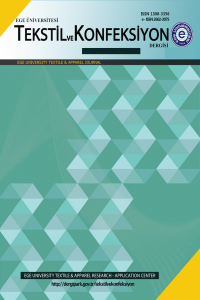FARKLI DOKUMA KUMAŞLARIN NEM İLETİM ÖZELLİKLERİNİN KARŞILAŞTIRILMASI
Giysi konforu, giysi biliminin çekici bir konusudur ve günümüzde giysi konforunun liflerin ve hatta kumaşların ısıl özellikleri, dokunma hissi vb. gibi birçok faktörlerle iyi bir bağlantısı olduğu bilinmektedir. Kumaşların nem iletim özelliği de giysi konforuyla ilgili başka bir önemli parametredir. Bu çalışmada, MMT test cihazı kullanılarak farklı liflerlerden dokunan kumaşların sıvı nem iletim özelliklerinin göstergeleri, derecelendirilmesi ve sınıflandırma metotlarının değerlendirilmesi üzerine odaklanılmıştır. % 100 selülozik ve poliester kumaşların aksine, selülozik/poliester karışımı kumaşların etkili bir şekilde sıvı absorbsiyonu ve iletimini sağladığı bulunmuştur
Anahtar Kelimeler:
Sıvı nem iletimi, Dokuma kumaş, Selülozik, Poliester, Nem iletim cihazı
COMPARISON OF MOISTURE TRANSPORT PROPERTIES OF THE VARIOUS WOVEN FABRICS
Clothing comfort is an attractive topic of clothing science and today it is known that clothing comfort have a good relation with the several factors such as thermal, tactile properties, etc of fibers and also fabrics. Moisture management property of fabrics is also another important parameter related with clothing comfort. In this study, it was focused on the evaluation of indices of liquid moisture management properties, grading and classification methods of woven fabrics with various fibers by using MMT tester. It was found that unlike 100% Cellulosic and PES fabrics, Cellulosic/PES blended fabrics allowed the liquid absorption and transportation efficiently
Keywords:
Liquid moisture management, Woven fabric, Cellulosic, Polyester, Moisture management tester,
___
- 1. Buhler, M., Iyer, C., 1988, “An Investigation into Opportunities for Further Developments of Functional Knitwear for the Sportswear Sector”, Knitting Technique, 10(5), pp. 303–307.
- 2. Chen, T. W., Fu, J. Q., Li, W. Z., Gao, X. S., 2005, “Moisture Absorption and Release Performance of Fabrics”, Clothing Technology, 25(4), pp. 48–56.
- 3. Loy, W., 1990, “Functional Sportswear”, Knitting Technique, 12(3), pp. 211–213.
- 4. Jun, Y., Park, C. H., Shim, H., Kang, T. J., 2009, “Thermal Comfort Properties of Wearing Caps from Various Textiles”, Textile Research Journal, 79, pp. 179-189.
- 5. Su, C. I., Fang, J. X., Chen, X. H., Wu, W. Y., 2007, “Moisture Absorption and Release of Profiled Polyester and Cotton Composite Knitted Fabrics”, Textile Research Journal, 77, pp. 764-769.
- 6. http://defense-update.com/products/m/moisture_management_fabric.htm
- 7. Yoo, S., Barker, R. L., 2004, “Moisture Management Properties of Heat-Resistant Workwear Fabrics Effects of Hydrophilic Finishes and Hygroscopic Fiber Blends”, Textile Research Journal, 74, pp. 995-1000.
- 8. Yao, B., Li, Y., Hu, J., Kwok, Y., Yeung, K., 2006, “An improved test method for characterizing the dynamic liquid moisture transfer in porous polymeric materials”, Polymer Testing, 25, pp. 677–689.
- 9. Li, Y., Xu, W., Yeung, K. W. 2002, “Moisture management of textiles”, US Patent No. 6.499.338B2.
- 10. Wong, A., Li, Y., Yeung, K.W., 2002, “Psychological sensory perceptions and preferences of young adults towards tight fit sportswear”, The Journal of Textile Institute
- 11. Hu, J., Li, Y., Yeung, K., Wong, A. S. W., Xu, W., 2005, “Moisture Management Tester: A Method to Characterize Fabric Liquid Moisture Management Properties”, Textile Research Journal, 75(1), pp. 57–62.
- 12. Moisture Management Tester Operation Manual, 2009
- 13. Zhou, L., Feng, X., Du, Y., Li, Y., 2007, “Characterization of Liquid Moisture Transport Performance of Wool Knitted Fabrics”, Textile Research Journal, 77, pp. 951-956.
- 14. Özdil, N., Süpüren, G., Özçelik, G., Průchová, J., 2009, “A Study on the Moisture Transport Properties of The Cotton Knitted Fabrics in Single Jersey Structure”, Tekstil ve Konfeksiyon, No: 3, pp. 218-223.
- 15. Fichet, D., Lesage, F., Ventenat, V., Latifi, M.A., 2005, “Water Spreading Analysis on Fabrics Surfaces”, COMSOL Multiphysics User's Conference, Paris.
- ISSN: 1300-3356
- Yayın Aralığı: Yılda 4 Sayı
- Başlangıç: 1991
- Yayıncı: Ege Üniversitesi
Sayıdaki Diğer Makaleler
Zümrüt BAHADIR ÜNAL, Ziynet ÖNDOĞAN, Hasan YÜKSEL
TÜRK KADINLARININ VÜCUT ŞEKİLLERİ: HAZIR GİYİM AÇISINDAN
KONFEKSİYONDA İŞ ÖRNEKLEMESİ METODU VE YAKINLIK DERECESİ PROSEDÜRÜ İLE YERLEŞİM PLANLAMASI
Mücella GÜNER, Can ÜNAL, Cihat ARIKAN
Faruk BOZDOĞAN, İsmail TİYEK, Gonca ÖZÇELİK KAYSERİ
FARKLI DOKUMA KUMAŞLARIN NEM İLETİM ÖZELLİKLERİNİN KARŞILAŞTIRILMASI
E. Sema NAMLIGÖZ, Süleyman ÇOBAN, M. İbrahim BAHTİYARİ
%100 YÜNLÜ DOKUMA KUMAŞLARIN KONVANSİYONEL VE ULTRASONİK ENERJİ YÖNTEMİ İLE BOYANMASI
S. Müge YÜKSELOĞLU, Neslihan BOLAT
DOKUMA KUMAŞLARIN ÖZNEL ALGISI İLE BAZI FİZİKSEL ÖZELLİKLERİ ARASINDAKİ İLİŞKİNİN BELİRLENMESİ
Pelin GÜRKAN ÜNAL, Nilgün ÖZDİL, Cankut TAŞKIN, M. Fikri ŞENOL
